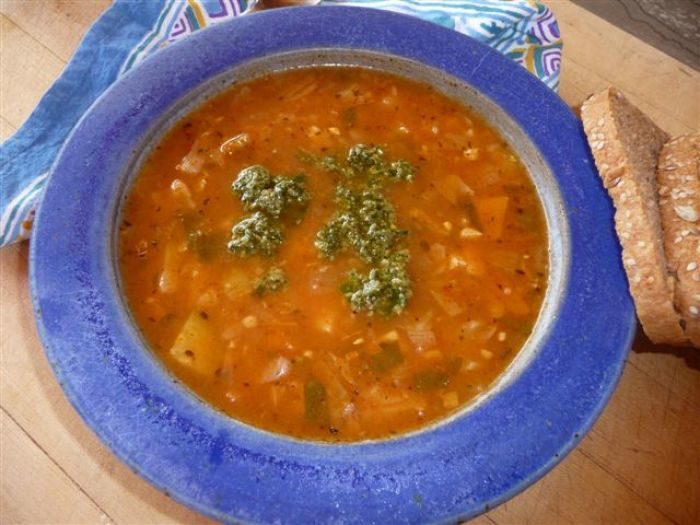
Ingredients:
Makes about 1-1/2 cups
5 cloves garlic, peeled and sliced
1/4 cup pine nuts
4 cups basil leaves
Salt
1/2 cup freshly grated parmesan cheese
About 3/4 cup extra-virgin olive oil
This is a classic version of the famous Italian sauce. Excerpted from Basil: An Herb Lover’s Guide by Thomas DeBaggio and Susan Belsinger, Interweave Press, 1996.
For centuries, Italians have made pesto with a mortar and pestle, hence the name pesto from the verb pestare, which means to pound or grind. Pesto prepared in this manner is by far the best, it has a wonderful emulsion and is thick and creamy. The flavors are also more intense–the garlic is more pungent, the nuts are sweeter and more resinous, and the basil is rich in perfume. Nowadays, many of us use the food processor to make pesto since it is quick and easy. Directions for both methods are given below. Traditionally, pesto is served with a flat-type noodle such as trenette, fettuccine, or linguine.
I prefer Parmigiano Reggiano for making pesto, but a less-aged Italian Parmesan such as Grana Padana can also be used. In Italy a sheep’s cheese called Pecorino Romano is often used. Depending on the time of year and the type of basil and garlic that you use flavors will vary in strength, so you may have to add more of one or the other. If the pesto tastes sharp, add more Parmesan cheese, if it is too thick, thin it with a little olive oil.
Combine the garlic and pine nuts in a large mortar and crush them with the pestle into a smooth paste. Add the basil to the mortar, a handful at a time, crushing the leaves against the sides with the pestle. The mixture will be like a coarse, thick paste until the oil is added. Add a few pinches of salt to the basil.
Drizzle the olive oil in slowly, a bit at a time, as you work it in. The pesto should become very smooth and there should not be any big pieces. Stir in the cheese. Once most of the oil is added, taste for seasoning and adjust with a little more oil, cheese, or salt.
If you are using a food processor, combine the garlic, pine nuts, basil, few pinches salt, and a few tablespoons of the oil. Process until mixed. Add the cheese and most of the remaining oil and process until smooth and homogenous. Taste for seasoning, and add the rest of the oil, and a little more cheese or salt, if desired.
Though it isn’t as wonderful as just-made, leftover pesto is still good after three or four days if it is kept tightly-covered in the refrigerator. The top layer will darken some; just stir it in.
Fine Gardening Recommended Products

A.M. Leonard Deluxe Soil Knife & Leather Sheath Combo
Fine Gardening receives a commission for items purchased through links on this site, including Amazon Associates and other affiliate advertising programs.

Gardener's Log Book from NYBG
Fine Gardening receives a commission for items purchased through links on this site, including Amazon Associates and other affiliate advertising programs.

Berry & Bird Rabbiting Spade, Trenching Shovel
Fine Gardening receives a commission for items purchased through links on this site, including Amazon Associates and other affiliate advertising programs.



















Comments
Log in or create an account to post a comment.
Sign up Log in